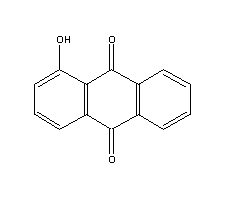| Identification |
| Name: | 9,10-Anthracenedione,1-hydroxy- |
| Synonyms: | Anthraquinone,1-hydroxy- (8CI); 1-Hydroxy-9,10-anthracenedione; 1-Hydroxy-9,10-anthraquinone;1-Hydroxyanthraquinone; Erythroxyanthraquinone; NSC 8640; a-Hydroxyanthraquinone |
| CAS: | 129-43-1 |
| EINECS: | 204-946-7 |
| Molecular Formula: | C14H8 O3 |
| Molecular Weight: | 224.22 |
| InChI: | InChI=1/C14H8O3/c15-11-7-3-6-10-12(11)14(17)9-5-2-1-4-8(9)13(10)16/h1-7,15H |
| Molecular Structure: |
 |
| Properties |
| Flash Point: | 218.8°C |
| Boiling Point: | 414.8°Cat760mmHg |
| Density: | 1.423g/cm3 |
| Refractive index: | 1.695 |
| Solubility: | 0.5 mg/L (25 C) |
| Appearance: | Red-orange to fine yellow crystals |
| Report: |
Reported in EPA TSCA Inventory.
|
| Flash Point: | 218.8°C |
| Storage Temperature: | Storage site should be as close as practical to lab in which carcinogens are to be used, so that only small quantities required need to be carried. Carcinogens should be kept in only one section of storage cabinet, explosion-proof refrigerator or freezer that bears appropriate label. |
| Color: | Orange red needles
Red-orange needles from ethyl alcohol
Orange-red to fine yellow crystals in ethanol |
| Usage: | 1-Hydroxyanthraquinone can be used as an intermediate in the production of dyes and drugs. |
| Safety Data |
| |
 |